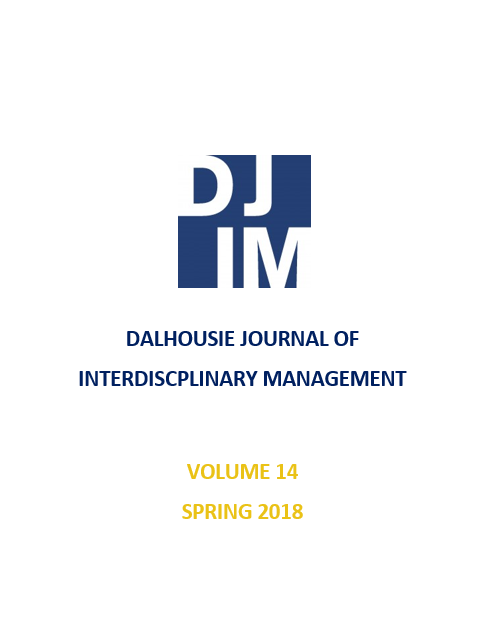Blockchain Tracking and Cannabis Regulation: Developing a permissioned blockchain network to track Canada's cannabis supply chain
DOI:
https://doi.org/10.5931/djim.v14i0.7869Abstract
Achieving government‘s goals for cannabis regulation requires legal cannabis to be a cheaper, more attractive consumer alternative compared to the illegal market. This goal may be undermined by the costs and disadvantages of traditional regulatory management.
A Canada wide, real-time blockchain tracking system appears to be a viable technical solution architecture.
A permissioned blockchain network could be tested alongside traditional tracking. This investment, if proven effective, could reduce regulatory costs for government and red tape for business, helping to achieve Governments‘ objectives to:
- Enhance public safety by ensuring quality and monitoring product sales
- Undermine illegal markets to reduce crime and prevent product diversion
References
BioTrackTHC. (2016). Secure Cannabis Software Solutions You Can Count On. Retrieved from https://www.biotrack.com/
Deloitte. (2017). Using blockchain to drive supply chain innovation: A series exploring industry 4.0 technologies and their potential impact for enabling digital supply network in manufacturing. Retrieved from https://www2.deloitte.com/content/dam/Deloitte/us/Documents/process-and-operations/us-blockchain-to-drive-supply-chain-innovation.pdf
Forbes. (2017). Alibaba, EY, IBM and Microsoft Use The Blockchain To Create A Transparent Supply Chain. Retrieved from https://www.forbes.com/sites/jwebb/2017/08/31/alibaba-ey-ibm-and-microsoft-use-the-blockchain-to-create-a-transparent-supply-chain/#2b6000e44b37
Government of Canada. (2016). A Framework for The Legalization and Regulation of Cannabis in Canada: The final report of the task force on cannabis legalization and regulation. Retrieved from http://healthycanadians.gc.ca/task-force-marijuana-groupe-etude/framework-cadre/alt/framework-cadre-eng.pdf
Government of Canada. (2017). Compliance and Enforcement of the Access to Cannabis for Medical Purposes Regulations. Retrieved from https://www.canada.ca/en/health-canada/services/drugs-health-products/medical-use-marijuana/compliance-enforcement.html
Government of Canada. (2018a). Access to Cannabis for Medical Purposes Regulations: Division 5 – Record Keeping by Licensed Producer. Retrieved from http://laws.justice.gc.ca/eng/regulations/SOR-2016-230/page-20.html#h-27
Government of Canada. (2018b). Legalizing and strictly regulating cannabis: the facts. Retreived from https://www.canada.ca/en/services/health/campaigns/legalizing-strictly-regulating-cannabis-facts.html
IBM. (2017a). BlockChain: An Irrefutable Chain of Custody Audit for the Seed to Sale of Cannabis in BC. Retrieved from https://engage.gov.bc.ca/app/uploads/sites/217/2017/11/IBM-Canada.pdf
IBM. (2017b). BlockChain Explained: The difference between public and private blockchain. Retrieved from https://www.ibm.com/blogs/blockchain/2017/05/the-difference-between-public-and-private-blockchain/
Maclean‘s. (2017). How big is Canada‘s marijuana market, really?. Retrieved from http://www.macleans.ca/news/canada/how-big-is-canadas-marijuana-market-really/
METRC. (2016). The System. Retrieved from https://www.metrc.com/the-system
Nakamoto, S. (2008). Bitcoin: A peer-to-peer electronic cash system. Retrieved from https://bitcoin.org/bitcoin.pdf
Ramachandran, A., & Kantarcioglu, D. (2017). Using Blockchain and smart contracts for secure data provenance management. Fourth International Conference on Computer Science and Information Technology.
Visa. (2017). Visa Public Key Infrastructure: Certificate Policy (CP). Retrieved from https://www.visa.com/pki/pdf/VisaPublicKeyInfrastructureCertificatePolicy.pdf
Downloads
Published
Issue
Section
License
Papers published in the Dalhousie Journal of Interdisciplinary Management must be the original, unpublished work of the author. Contributors are responsible for obtaining any copyright clearances required in relation to their work.
Authors submitting a paper to the Dalhousie Journal of Interdisciplinary Management automatically agree to grant a limited license to DJIM if and when the manuscript is accepted for publication. This license gives permission for DJIM to publish the paper in a given issue and to maintain the work in the electronic journal archive. DJIM also submits issues to institutional repositories and Open Access repositories.
Contributors agree to each reader accessing, downloading, or printing one copy of their article for their own personal use or research. All other copyrights remain with the author, subject to the requirements that any republication of the work be accompanied by an acknowledgement that the work was first published in the Dalhousie Journal of Interdisciplinary Management and that the DJIM Editorial Chair must be notified of any republication of a work first published in DJIM.
Dalhousie Journal of Interdisciplinary Management
c/o School of Information Management
Faculty of Management
Dalhousie University
Kenneth C. Rowe Management Building
6100 University Avenue
Halifax, Nova Scotia B3H 3J5
Canada
Email: djim@dal.ca
Authors should recognize that, because of the nature of the Internet, the publisher has no control over unauthorized copying or editing of protected works.


